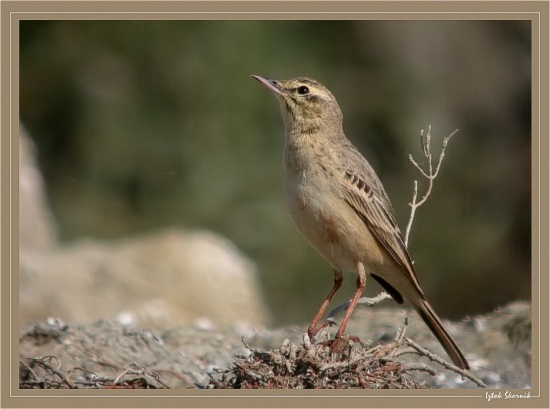Aloktewari (talk | contribs) (Video link added) |
(→External Links: Multiple GSearches combined) |
||
| (15 intermediate revisions by 5 users not shown) | |||
| Line 1: | Line 1: | ||
| − | [[Image:Tawny_Pipit.jpg|thumb|550px|right|Photo by {{user|Mugil|Mugil}}<br />Secovlje Salina, [[Slovenia]]]] | + | [[Image:Tawny_Pipit.jpg|thumb|550px|right|Photo © by {{user|Mugil|Mugil}}<br />Secovlje Salina, [[Slovenia]], May 2005]] |
;[[:Category:Anthus|Anthus]] campestris | ;[[:Category:Anthus|Anthus]] campestris | ||
==Identification== | ==Identification== | ||
| + | [[Image:IMG 49762.jpg|thumb|350px|right|Photo © by {{user|barty63|Mike Barth}}<br />Dibba, [[UAE]], 22 October 2011]] | ||
16.5-18 cm (6½-7 in)<br /> | 16.5-18 cm (6½-7 in)<br /> | ||
The pale sandy plumage, bold eye-stripe and prominent line of black feathers on the median coverts are also useful features.<br /> | The pale sandy plumage, bold eye-stripe and prominent line of black feathers on the median coverts are also useful features.<br /> | ||
'''Juveniles''' are more heavily streaked and hence are confusable with [[Richard's Pipit]]s, but are sleeker and always show distinctive dark lores. | '''Juveniles''' are more heavily streaked and hence are confusable with [[Richard's Pipit]]s, but are sleeker and always show distinctive dark lores. | ||
====Similar Species==== | ====Similar Species==== | ||
| + | [[File:Tawny_Pipit_Flight_2_BEVREJ.jpg|thumb|350px|right|Photo © by {{user|bievrejj|bievrejj}}<br />Port-Saint-Louis-du- Rhone, [[Camargue]], [[France]], 22 April 2022]] | ||
The almost complete lack of streaks on the underparts is one of the best ways to tell a Tawny Pipit, though beware summer plumage [[Water Pipit]]. Tawny Pipit looks bigger and leggier than other pipits. | The almost complete lack of streaks on the underparts is one of the best ways to tell a Tawny Pipit, though beware summer plumage [[Water Pipit]]. Tawny Pipit looks bigger and leggier than other pipits. | ||
==Distribution== | ==Distribution== | ||
| − | [[Europe]] and [[Asia]] and northwest [[Africa]]. | + | [[Europe]] and [[Asia]] and northwest [[Africa]], wintering to sub-Saharan Africa. |
==Taxonomy== | ==Taxonomy== | ||
| − | + | This is a [[Dictionary_M-S#M|monotypic]] species<sup>[[#References|[1]]]</sup>. | |
| − | + | ||
| − | + | Two subspecies have all been included under the main one, so ''kastschenkoi'' and ''griseus'' no longer recognized. | |
| − | |||
| − | |||
| − | |||
| − | |||
| − | |||
==Habitat== | ==Habitat== | ||
Dry open country including semi-deserts. | Dry open country including semi-deserts. | ||
| Line 26: | Line 23: | ||
It nests on the ground; the clutch consisting of 4-6 eggs. | It nests on the ground; the clutch consisting of 4-6 eggs. | ||
====Vocalisation==== | ====Vocalisation==== | ||
| − | + | {{ Audio|Anthus campestris (song).mp3 }} | |
| − | + | ||
==References== | ==References== | ||
| − | #{{Ref- | + | #{{Ref-Clements6thAug21}}#Handbook of the Birds of the World Alive (retrieved June 2015) |
{{ref}} | {{ref}} | ||
==External Links== | ==External Links== | ||
| − | {{GSearch|Tawny | + | {{GSearch|"Anthus campestris" {{!}} "Tawny Pipit"}} |
| − | + | {{GS-checked}}1 | |
| + | <br /> | ||
<br /> | <br /> | ||
| − | |||
| − | [[Category:Birds]] [[Category:Anthus]] | + | [[Category:Birds]] [[Category:Anthus]] [[Category:Bird Songs]] |
Latest revision as of 19:33, 30 May 2023
- Anthus campestris
Identification
16.5-18 cm (6½-7 in)
The pale sandy plumage, bold eye-stripe and prominent line of black feathers on the median coverts are also useful features.
Juveniles are more heavily streaked and hence are confusable with Richard's Pipits, but are sleeker and always show distinctive dark lores.
Similar Species
The almost complete lack of streaks on the underparts is one of the best ways to tell a Tawny Pipit, though beware summer plumage Water Pipit. Tawny Pipit looks bigger and leggier than other pipits.
Distribution
Europe and Asia and northwest Africa, wintering to sub-Saharan Africa.
Taxonomy
This is a monotypic species[1].
Two subspecies have all been included under the main one, so kastschenkoi and griseus no longer recognized.
Habitat
Dry open country including semi-deserts.
Behaviour
Their diet consists mostly of insects, including grasshoppers and locusts; supplemented with seeds.
Breeding
It nests on the ground; the clutch consisting of 4-6 eggs.
Vocalisation
References
- Clements, J. F., T. S. Schulenberg, M. J. Iliff, S. M. Billerman, T. A. Fredericks, J. A. Gerbracht, D. Lepage, B. L. Sullivan, and C. L. Wood. 2021. The eBird/Clements checklist of Birds of the World: v2021. Downloaded from https://www.birds.cornell.edu/clementschecklist/download/
- Handbook of the Birds of the World Alive (retrieved June 2015)
Recommended Citation
- BirdForum Opus contributors. (2025) Tawny Pipit. In: BirdForum, the forum for wild birds and birding. Retrieved 9 May 2025 from https://www.birdforum.net/opus/Tawny_Pipit
External Links
GSearch checked for 2020 platform.1






